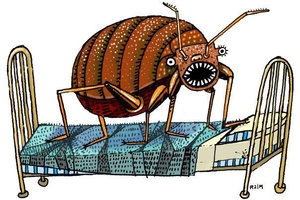Putting the bed bug issue to bed
by Claire Carusillo '13
FEATURES EDITOR
Terry Hawkridge wants Hamilton students to know that their campus is free of bed bugs. The Assistant Director of Grounds, Horticulture and Arboretum is talking, of course, about the recent reports of bed bug infestation in Hamilton residence halls. These reports led to an investigation over winter break which found no additional cases of infestation.
Bed bugs are blood-feasting insects that cause allergic reactions and skin irritations for their sleeping human victims and spread by hiding in folds in clothing and other fabrics. The initial cases of bedbugs occurred in Dunham Hall last September when a visiting former student hosted one of the parasitic bugs on his backpack.
Within 24 hours, Hawkridge and the Physical Plant team fumigated the room in which bugs were found, along with the surrounding rooms. Before winter break, another student in Dunham reported bed bugs. This second report spurred a campus-wide investigation of the problem on Dec. 20 and 21.
Although these incidents are technically an infestation, Hawkridge wants to exercise caution when defining what “infestation” really means. “A female adult bed bug can lay up to ten eggs a day. We found a couple dozen [eggs] — yes, that’s an infestation, but not a big one by any means,” Hawkridge said. Even so, Hawkridge stresses that bed bugs will not be tolerated on Hamilton’s campus and that Physical Plant takes immediate action with reports.
To follow up on last semester’s report, Hawkridge randomly searched rooms in each of the campus residence halls. “I felt a little uncomfortable doing it because I felt like I would want the occupant there with me, but it was done respectfully,” he explained. “We didn’t find anything.”
Student cooperation was essential to the success of the bed bug investigations. Before winter break, students were instructed to remove the linens from their beds, launder them, and then store them in a knotted plastic bag before they left campus. Hawkridge commented, “When I randomly went into a couple of rooms in a lot of dorms, I saw that the students did comply with our requests. I didn’t find any beds that still had linens on them.”
No bed bugs were found in any other randomly searched room on campus, though one occupant in Major refused an inspection. Additionally, the room in Dunham that had a bed bug issue earlier in the year underwent a third fumigation treatment and Hawkridge found no further bed bugs in the room. If Hawkridge had found bed bugs in any residence hall, the Physical Plant team would have emptied the room, washed the linens, place unsoiled clothing in the dryer to kill the bugs, and sprayed the room with a chemical spray. Fourteen days later, the team would come back and spray the room again.
Physical Plant also left mousetraps in the Bristol Center as well as the Rogers, West Bundy, North, South and Saunders dormitories, and addressed ant problems in Wertimer dormitory. In addition to those treatments, Hawkridge said that the campus is working closely with a pesticide company and will begin working with a hound dog to track down the scent of bed bugs. He said, “A beagle can smell the sweet smell that beg bugs give off. At least once a year, we’ll have a beagle come around and inspect rooms.”
Hawkridge concedes that although he “did not find bed bugs in any rooms …we did find rooms in various degrees of cleanliness.”
Although bed bugs may be considered to be dirty creatures, the few students who have found bed bugs in their rooms are not to be stigmatized as such — bed bugs spread due to the mobile campus population, not from poor hygiene. Their presence has nothing to do with lack of cleanliness. “You could go down to the Ritz Carlton today and find bed bugs,” Hawkridge said, “It’s not about sanitation.” Therefore, Hamilton students should think twice before calling notorious residence halls like Dunham “dirty” because of bed bugs—that may true, but on its own merit, not because of bed bugs.
